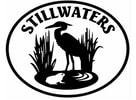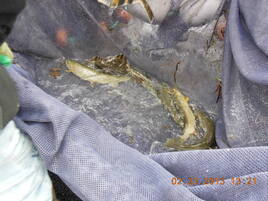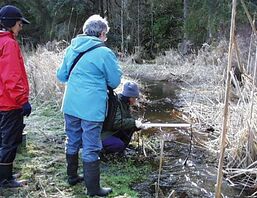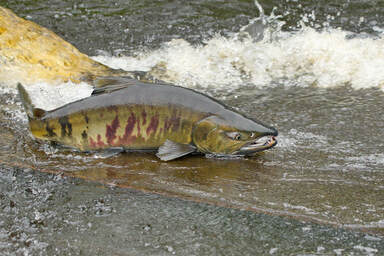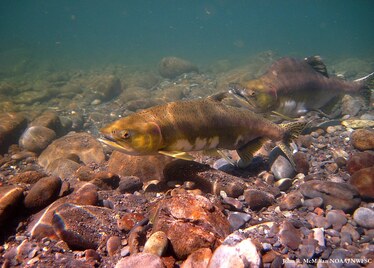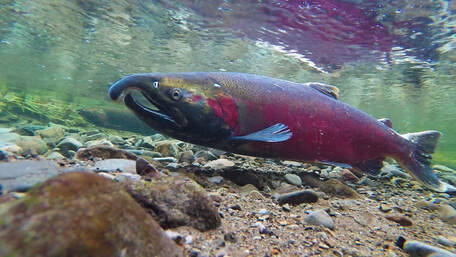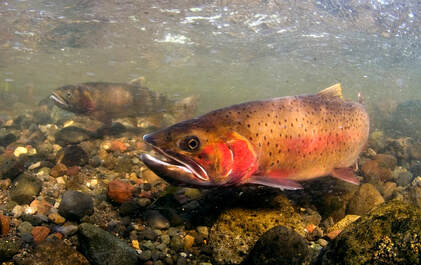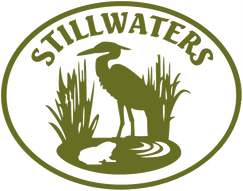Salmon
Salmon are an important resource for ocean species such as Killer Whales (Orcas) and is even the primary food source for the Southern Resident Killer Whales, an endangered species. All life stages are important sources of nutrition for a wide variety of freshwater and terrestrial species, cycling nutrients from the ocean back to the land for trees and other terrestrial plants as well as for animals.
Salmon are "anadromous" which means that they breed in fresh water but spend much of their lives in the ocean. There are seven different species of anadromous salmonids (salmon and trout) in the Pacific Northwest and there is also great variation in the life histories of within and between species, e.g., sockeye can be anadromous or spend all of their lives in freshwater lakes (known as kokanee); other species can have spring, summer, fall or winter 'runs' that are genetically distinct from one another; chum spend only a few days or weeks in fresh water after hatching while coho can spend two years before heading downstream to the ocean.
Salmon have also been culturally important to tribal communities around the Pacific Northwest for thousands of years. Traditions involving salmon extend all the way until the bones are returned to the stream to show they are welcome back. Five treaties negotiated with Western Washington tribes in 1854-55 guaranteed that the tribes would be able to continue to harvest fish in their "usual and accustomed" places. Since the 1974 Boldt decision, which, among other things, designated tribes as co-managers of salmon resources in Washington state, various courts, including the U.S. Supreme Court, have continued to interpret the treaty language as meaning that salmon populations must be conserved and not allowed to go extinct.
Salmon are "anadromous" which means that they breed in fresh water but spend much of their lives in the ocean. There are seven different species of anadromous salmonids (salmon and trout) in the Pacific Northwest and there is also great variation in the life histories of within and between species, e.g., sockeye can be anadromous or spend all of their lives in freshwater lakes (known as kokanee); other species can have spring, summer, fall or winter 'runs' that are genetically distinct from one another; chum spend only a few days or weeks in fresh water after hatching while coho can spend two years before heading downstream to the ocean.
Salmon have also been culturally important to tribal communities around the Pacific Northwest for thousands of years. Traditions involving salmon extend all the way until the bones are returned to the stream to show they are welcome back. Five treaties negotiated with Western Washington tribes in 1854-55 guaranteed that the tribes would be able to continue to harvest fish in their "usual and accustomed" places. Since the 1974 Boldt decision, which, among other things, designated tribes as co-managers of salmon resources in Washington state, various courts, including the U.S. Supreme Court, have continued to interpret the treaty language as meaning that salmon populations must be conserved and not allowed to go extinct.
|
Salmon in the Carpenter Creek Watershed
|
|
Carpenter Creek is a spawning stream
Stream typing (identifying whether a stretch of stream has fish) conducted by the Wild Fish Conservancy in 2011, found abundant healthy young coho in Carpenter Creek in May. Salmonids, including cutthroat trout and juvenile coho, are often observed during stream and estuary monitoring. Spawned out salmon are found walking the creek in the fall. Beach seining in May reveals hundreds of coho smolts in the estuary, transitioning from fresh to salt water.
|
The Estuary is critical habitat for juveniles
Beach seining with the Suquamish Tribe and WDFW between 2004 and 2015 determined that 5 species of salmonid used the Carpenter Creek estuary as juveniles. Species included Coho, Chum, and Cutthroat trout known to spawn in Carpenter Creek and other Kitsap streams. Chinook and pink salmon were also found, highlighting the importance of estuaries to juvenile salmon from other watersheds during their migration to the ocean.
|
Monitoring for stream and estuary health
Monitoring by Stillwaters' volunteers and interns document the health of of the watershed. Water quality monitoring in particular is important to ensure that conditions in the creek and estuary are suitable for salmon and other organisms.
|
Viewing salmon in Kitsap County
There are many places in the Pacific Northwest where one can see salmon moving upstream to spawn. Below are visual aids to help identify salmon in their spawning stages. Salmon look different at different life stages. As juveniles in fresh water and while living in salt water, their main goal is to survive and consume as many nutrients as possible, so they are colored to blend in with their habitat. However, when they return to streams to spawn, their color and anatomy changes.
CHUM SALMONChum are very populous in other streams in Kitsap County and can be seen in lower Carpenter Creek. There is a distinctive vertical stripped pattern on the side of spawning male chum (as seen below) and a more visible horizontal line on the female.
PINK SALMONBelow is a picture of a female (in the front) and male (in the back) spawning. Pink salmon are not known to use Carpenter Creek for spawning but use the estuary as juveniles. Notice the large hump on the back of the male!
|
COHO SALMONCarpenter Creek is home to many Coho salmon and is a productive stream for them. Coho spawning males (as seen below) are very bright compared to the water they are usually in, making it very easy to identify this species. Carpenter Creek coho returning to spawn can sometimes be seen in the pool downstream from the South Kingston Bridge during November.
CHINOOK SALMONChinook do not spawn in small lowland streams like Carpenter Creek but juveniles use the estuary for feeding and resting during their outward migration to the ocean . Notice the spots on the Chinook, this feature can help identify Chinook Salmon.
|
CUTTHROAT
Cutthroat are a part of the salmon family, however they, like steelhead (an anadramous form of rainbow trout) can survive spawning, go back to the ocean, and return again to spawn several times. Salmon can't do this, they die after spawning once.
Keep in mind: Salmon have a line that runs down their side that senses vibrations. It's important to stay away from stream beds especially when salmon are present/trying to spawn because the vibrations caused by our movements can disturb their life cycle process or scare them away.
Below is a link to a virtual Kitsap County Salmon Guide flip book. There is lots of general information about salmon and their importance in Kitsap County located here.
